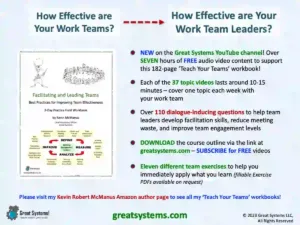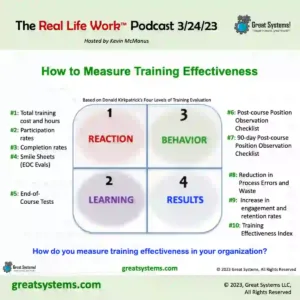The AURA of an effective training system maximizes the amount of course content students are aware of, understand, retain, and apply.
The AURA of Effective Training
Do you want to maximize the amount of course content students are aware of, understand, retain, and apply? If so, consider the AURA of an effective training system. My experiences as a trainer have taken many forms over the years, but the AURA always applies..
For the past twenty years, I have been solely doing classroom style training. You know, the kind where a presenter shares their data viz and talks. Of course, we must realize that if we drone on, we saddle our students with the low probability of actual skill retention.
Prior to that time, I hardly did any classroom style training at all. Paradoxically, even though I was plant manager in a rapidly growing company, I had a significant need to teach people on an almost daily basis. Which experience represents more effective training?
Since March 2020, most of my training has been of the virtual nature. After hundreds of classroom days as a virtual facilitator, I have learned a lot and improved my courses. You can read about my virtual training experience thoughts in my post on that topic.
If you would like to explore how I teach a virtual course that is 35% lecture and 65% exercise-based, check out my post on my experiences teaching the 3-day virtual TapRooT® root cause analysis course.
How Effective is Your Training Work System?
In all three cases, I spend a lot of time with a lot of students. In each cases, I think they actually learn something. As I compare how each format uses training time from a training effectiveness perspective, I continue to ask. To what degree do I truly deliver classroom, virtual, and on-the-job training that is value added?
If you have read my content before, you may know my opinions about classroom training. In short, I think most lecture-based training is a waste of time. The statistics show that people retain, let alone apply, very little of what they hear in a lecture over the weeks that follow course completion.
Previously, classroom training was the dominant training delivery method. Computer-based training (CBT) is now in the lead. I am a cost-conscious industrial engineer at heart, and I know that organizations collectively invest millions of dollars in training each day. This really bothers me. I could easily go off on a rant about this, but I already used post space to do so in the past on this topic.
Instead, we would be better off to talk about what we might want to try to do to improve the situation. I really doubt that the number of hours we spend on training each year will decline in future years.
LISTEN and IDEATE: ‘How to Measure Training Effectiveness’ Real Life Work podcast
The Need for Training Work System Improvement
Training design and delivery is definitely a process that cries out for improvement. Also, there is an urgent need for this improvement to occur.
Our workforce continues to age and retire. Ideally, we capture and transfer all of that experiential knowledge our older employees possess to our younger folks. In reality, our seniors typically leave before we can video those key repair tricks that keep things in operation.
Business and education groups continue to debate about, and struggle to find, a way to better prepare graduates for the workplace. By the way, this was a problem twenty years ago. I don’t think we have made that much progress, but I do know that the workplace has sure changed a lot.
The bottom line is simple. We spend a lot of money on training. Plus, we don’t have very good metrics to gauge the effectiveness of this investment.
If my suspicions are correct, we waste a lot of money each day. In a lot of cases, we don’t seem to worry about this waste that much. Fortunately, the solution is also simple IF we can alter our mental models as to what really constitutes effective training.
At the start of this post, I stated that I did not do much classroom training as a plant manager. However, I did not state that we did not train our people. We did a lot of training, but not in the traditional lecture-based way.
Provide ‘Just In Time’ Skill Training Where the Work is Done
In essence, we trained on the job as the need arose. When I say ‘we’, I mean each of the leaders on our plant floor and in our support groups. The phrase ‘on the job’ means out on the floor where the work is done instead of in a classroom.
When I say ‘as the need arose’, I mean we look for learning moments as each day unfolds. We can use these moments to help meet the training needs we know exist from our performance trends and customer requirements.
This approach worked. However, as plant leaders, we had to perform our jobs as managers, supervisors, and support people in a manner that was quite different than the norm.
DISCOVER MORE: How to Measure and Improve Your Measurement Work System
We didn’t spend a lot of time in our offices or in meeting rooms. A lot of time was spent watching people work. We would ask people questions and review performance trends to help us be in a better position to consistently meet the needs of our customers.
This training tactic worked much better than bringing people into a classroom to cover job performance ‘how to’s’. We were able to provide immediate, and usually positive, performance feedback as our students ‘practiced.’
Plus, we could help them better retain and apply the skills we need them to use in the future. How do you measure and improve ‘on the job’ training effectiveness?
What is the AURA of Effective Training?
That’s what the AURA of effective training is all about. AURA is an acronym for Awareness-Understanding-Retention-Application.
In my previous life as a Training Manager, I began to use this four-word chain to help me develop more effective training. At that time, I called it the learning continuum. However, this all changed one day in class.
In the class, I was talking about the need to improve our training approaches. Our goal was to better bridge the gap between awareness creation and skill application.
One of my students pointed out that the four letters of this chain spelled out the word AURA. I was delighted with this observation. It sure made me glad that I try to let my students talk a little bit when I teach in a classroom setting.
Training Practice Fields Help Maximize Skill Retention
Do you want to improve your training process? If so, you must help your students actually retain and apply the skills you share with them in class. The easiest way to do this is to make our courses more practice focused when we have to present them in a classroom setting.
More importantly, we must find ways to spend a greater portion of our training time out on the practice field itself. It is tough to learn a lot in the locker room.
Buy my 162-page ‘Facilitating and Leading Teams’ DIY training workbook now on Amazon.com
Effective Training Requires Skill Repetition and Practice
Our people cannot effectively retain and apply most of the skills we need without repetition and practice. We can’t ensure our work teams retain and apply the right skills correctly unless we as leaders provide performance feedback on a regular basis.
To significantly decrease the amount of waste that occurs in the training world, we have to find ways to get out of our offices and meeting rooms.
Today’s leaders must spend time to actually help people learn, instead of listen to themselves talk. How do you teach people to lift safely?
Do you have them demonstrate safe lifts over and over or do you merely show and tell them how to lift correctly? How often do you simply show them a film or CBT PowerPoint on the topic? What degree of skill transfer truly occurs?
How Do You Learn to Remember?
If you doubt me, think about the last course you attended. How much of what you heard do you still remember?
Of those things you remember, how much do you actually use? For example, did you attend several days of statistics-laden six sigma training?
How much of this training do you remember and use? Do you feel competent to lead and facilitate a team after only two days of lecture on those topics? Would you like to practice those skills for a while before you begin to use them?
Don’t you think we need to improve our training processes a little bit here? Is there an aura of effectiveness that emanates from the training you participate in and provide?
I know that I continue to look for ways to practice more in my classrooms so my training is more effective. I hope you will as well.
Keep improving!
Kevin McManus, Chief Excellence Officer, Great Systems
WATCH over 50 kaizen and workplace health improvement videos on my Great Systems YouTube channel.
CHECK OUT my ‘Teach Your Teams’ workbooks on Amazon.com
LIKE Great Systems on Facebook
© Copyright 2024, Great Systems LLC, All Rights Reserved







